Analysis of Technology Needed by Third Parties in the Dance Industry
VerifiedAdded on 2023/05/30
|7
|1586
|62
Report
AI Summary
This report analyzes the technology needed by third parties to access services in the Australian dance industry. It identifies the technological infrastructure required, including network connections (wired, wireless, dialup), network-enabled devices (mobile phones, computers), and web browsers. The report also discusses the cost of implementation, including device purchases, network subscriptions, and security measures such as anti-malware software. Furthermore, it addresses security considerations, emphasizing the importance of security skills and refresher courses for platform users to protect personal data. The report concludes that meeting specific technical requirements is crucial before accessing any platform, highlighting the importance of understanding the technology required for seamless service access. Finally, it also covers the need for applications such as excel, word processing and notepad to open different data formats when downloaded from the website.
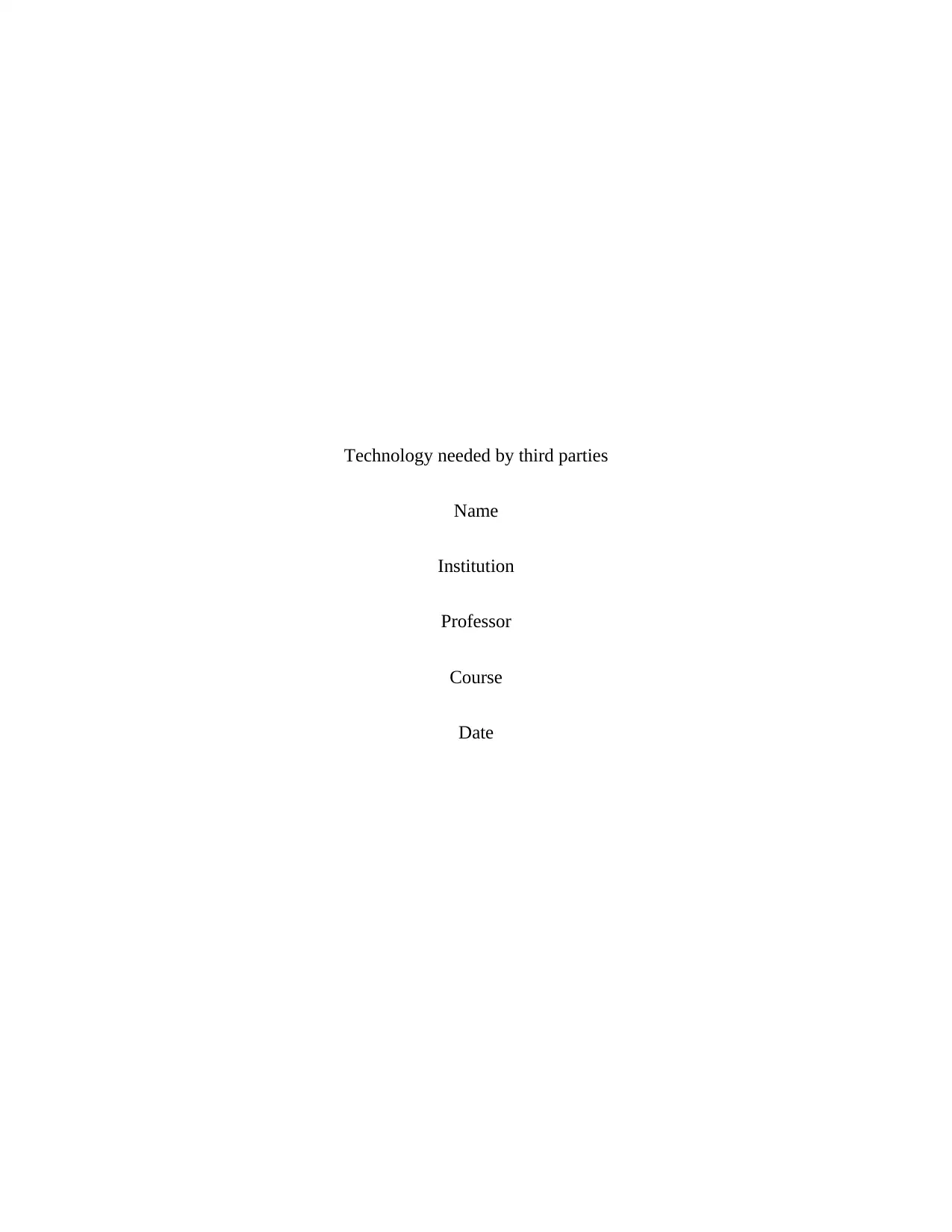
Technology needed by third parties
Name
Institution
Professor
Course
Date
Name
Institution
Professor
Course
Date
Paraphrase This Document
Need a fresh take? Get an instant paraphrase of this document with our AI Paraphraser
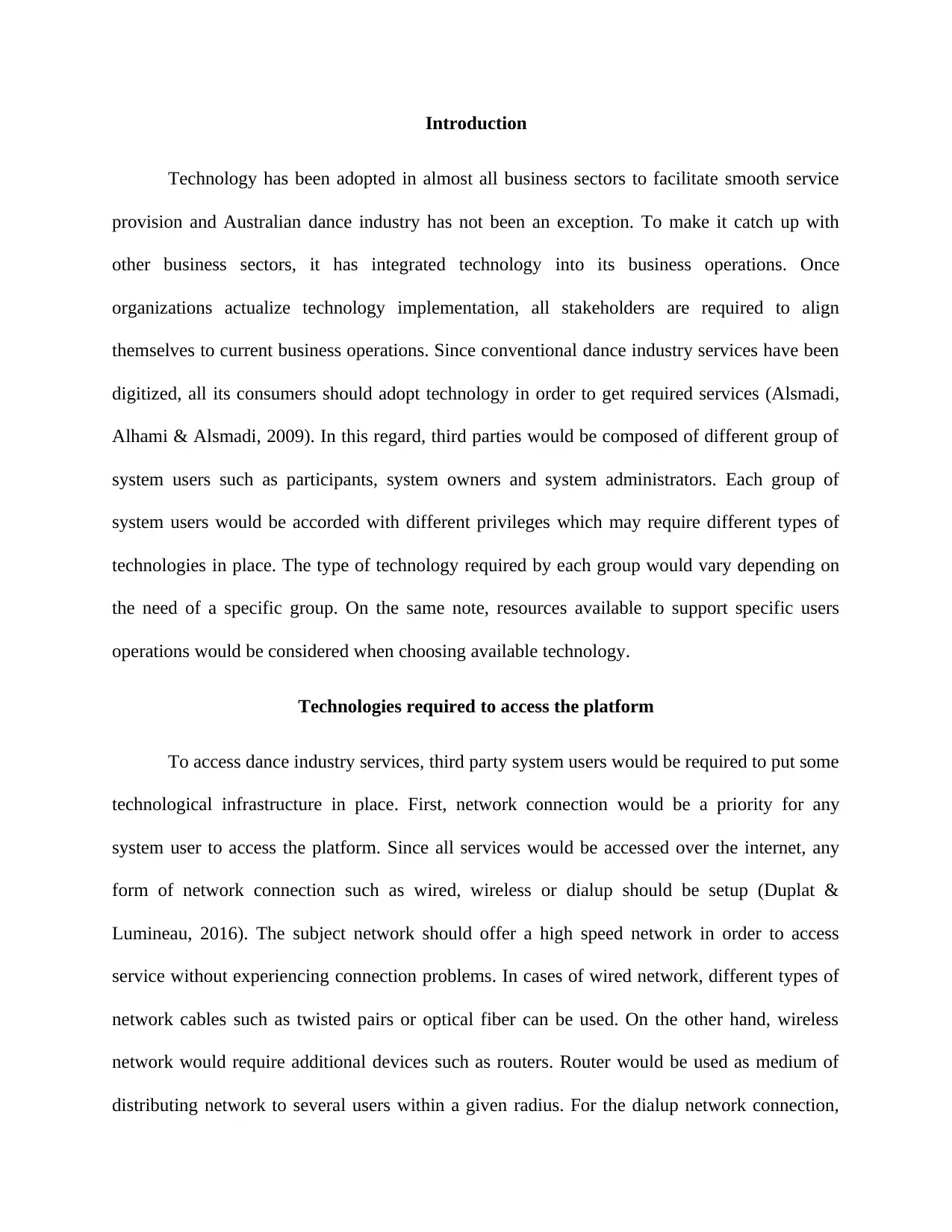
Introduction
Technology has been adopted in almost all business sectors to facilitate smooth service
provision and Australian dance industry has not been an exception. To make it catch up with
other business sectors, it has integrated technology into its business operations. Once
organizations actualize technology implementation, all stakeholders are required to align
themselves to current business operations. Since conventional dance industry services have been
digitized, all its consumers should adopt technology in order to get required services (Alsmadi,
Alhami & Alsmadi, 2009). In this regard, third parties would be composed of different group of
system users such as participants, system owners and system administrators. Each group of
system users would be accorded with different privileges which may require different types of
technologies in place. The type of technology required by each group would vary depending on
the need of a specific group. On the same note, resources available to support specific users
operations would be considered when choosing available technology.
Technologies required to access the platform
To access dance industry services, third party system users would be required to put some
technological infrastructure in place. First, network connection would be a priority for any
system user to access the platform. Since all services would be accessed over the internet, any
form of network connection such as wired, wireless or dialup should be setup (Duplat &
Lumineau, 2016). The subject network should offer a high speed network in order to access
service without experiencing connection problems. In cases of wired network, different types of
network cables such as twisted pairs or optical fiber can be used. On the other hand, wireless
network would require additional devices such as routers. Router would be used as medium of
distributing network to several users within a given radius. For the dialup network connection,
Technology has been adopted in almost all business sectors to facilitate smooth service
provision and Australian dance industry has not been an exception. To make it catch up with
other business sectors, it has integrated technology into its business operations. Once
organizations actualize technology implementation, all stakeholders are required to align
themselves to current business operations. Since conventional dance industry services have been
digitized, all its consumers should adopt technology in order to get required services (Alsmadi,
Alhami & Alsmadi, 2009). In this regard, third parties would be composed of different group of
system users such as participants, system owners and system administrators. Each group of
system users would be accorded with different privileges which may require different types of
technologies in place. The type of technology required by each group would vary depending on
the need of a specific group. On the same note, resources available to support specific users
operations would be considered when choosing available technology.
Technologies required to access the platform
To access dance industry services, third party system users would be required to put some
technological infrastructure in place. First, network connection would be a priority for any
system user to access the platform. Since all services would be accessed over the internet, any
form of network connection such as wired, wireless or dialup should be setup (Duplat &
Lumineau, 2016). The subject network should offer a high speed network in order to access
service without experiencing connection problems. In cases of wired network, different types of
network cables such as twisted pairs or optical fiber can be used. On the other hand, wireless
network would require additional devices such as routers. Router would be used as medium of
distributing network to several users within a given radius. For the dialup network connection,
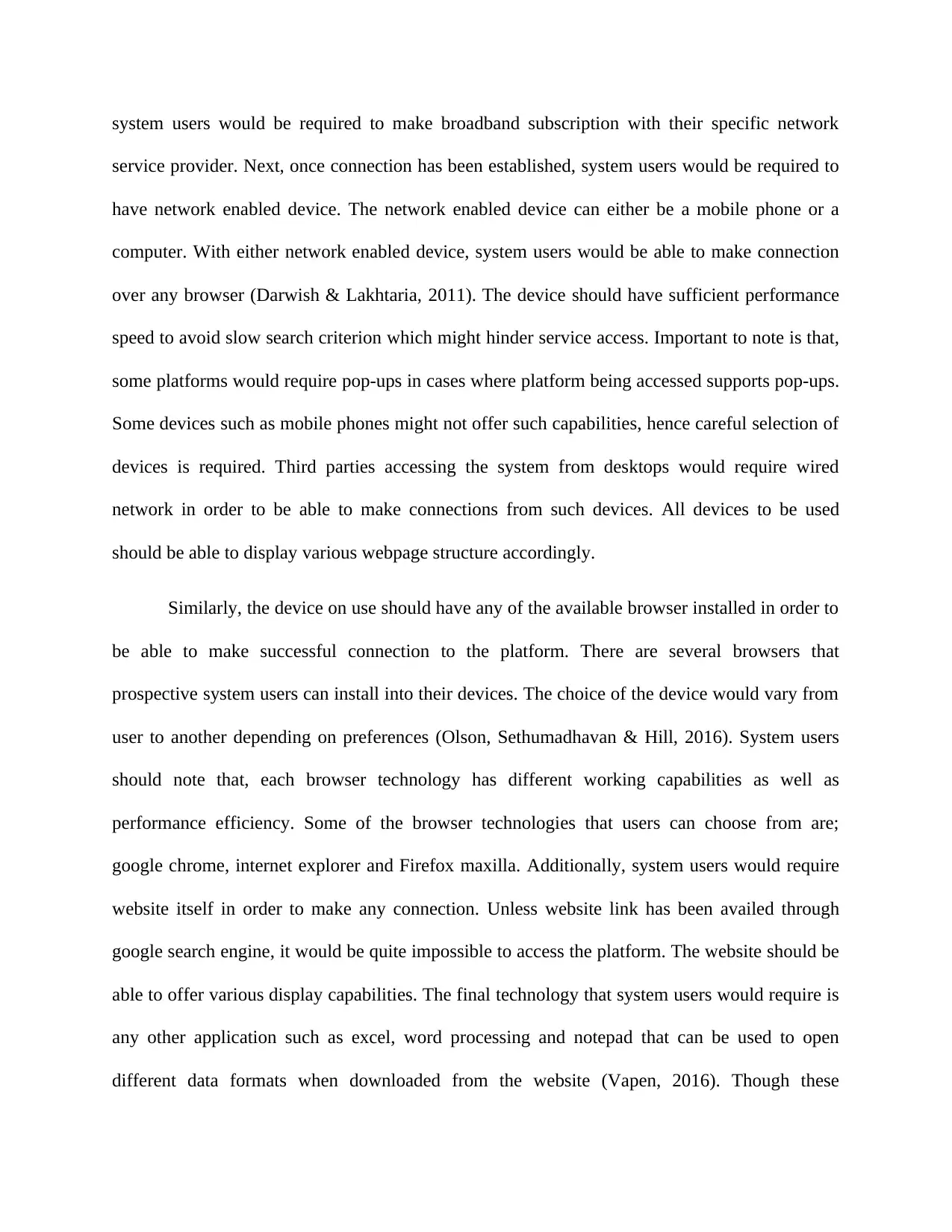
system users would be required to make broadband subscription with their specific network
service provider. Next, once connection has been established, system users would be required to
have network enabled device. The network enabled device can either be a mobile phone or a
computer. With either network enabled device, system users would be able to make connection
over any browser (Darwish & Lakhtaria, 2011). The device should have sufficient performance
speed to avoid slow search criterion which might hinder service access. Important to note is that,
some platforms would require pop-ups in cases where platform being accessed supports pop-ups.
Some devices such as mobile phones might not offer such capabilities, hence careful selection of
devices is required. Third parties accessing the system from desktops would require wired
network in order to be able to make connections from such devices. All devices to be used
should be able to display various webpage structure accordingly.
Similarly, the device on use should have any of the available browser installed in order to
be able to make successful connection to the platform. There are several browsers that
prospective system users can install into their devices. The choice of the device would vary from
user to another depending on preferences (Olson, Sethumadhavan & Hill, 2016). System users
should note that, each browser technology has different working capabilities as well as
performance efficiency. Some of the browser technologies that users can choose from are;
google chrome, internet explorer and Firefox maxilla. Additionally, system users would require
website itself in order to make any connection. Unless website link has been availed through
google search engine, it would be quite impossible to access the platform. The website should be
able to offer various display capabilities. The final technology that system users would require is
any other application such as excel, word processing and notepad that can be used to open
different data formats when downloaded from the website (Vapen, 2016). Though these
service provider. Next, once connection has been established, system users would be required to
have network enabled device. The network enabled device can either be a mobile phone or a
computer. With either network enabled device, system users would be able to make connection
over any browser (Darwish & Lakhtaria, 2011). The device should have sufficient performance
speed to avoid slow search criterion which might hinder service access. Important to note is that,
some platforms would require pop-ups in cases where platform being accessed supports pop-ups.
Some devices such as mobile phones might not offer such capabilities, hence careful selection of
devices is required. Third parties accessing the system from desktops would require wired
network in order to be able to make connections from such devices. All devices to be used
should be able to display various webpage structure accordingly.
Similarly, the device on use should have any of the available browser installed in order to
be able to make successful connection to the platform. There are several browsers that
prospective system users can install into their devices. The choice of the device would vary from
user to another depending on preferences (Olson, Sethumadhavan & Hill, 2016). System users
should note that, each browser technology has different working capabilities as well as
performance efficiency. Some of the browser technologies that users can choose from are;
google chrome, internet explorer and Firefox maxilla. Additionally, system users would require
website itself in order to make any connection. Unless website link has been availed through
google search engine, it would be quite impossible to access the platform. The website should be
able to offer various display capabilities. The final technology that system users would require is
any other application such as excel, word processing and notepad that can be used to open
different data formats when downloaded from the website (Vapen, 2016). Though these
⊘ This is a preview!⊘
Do you want full access?
Subscribe today to unlock all pages.

Trusted by 1+ million students worldwide
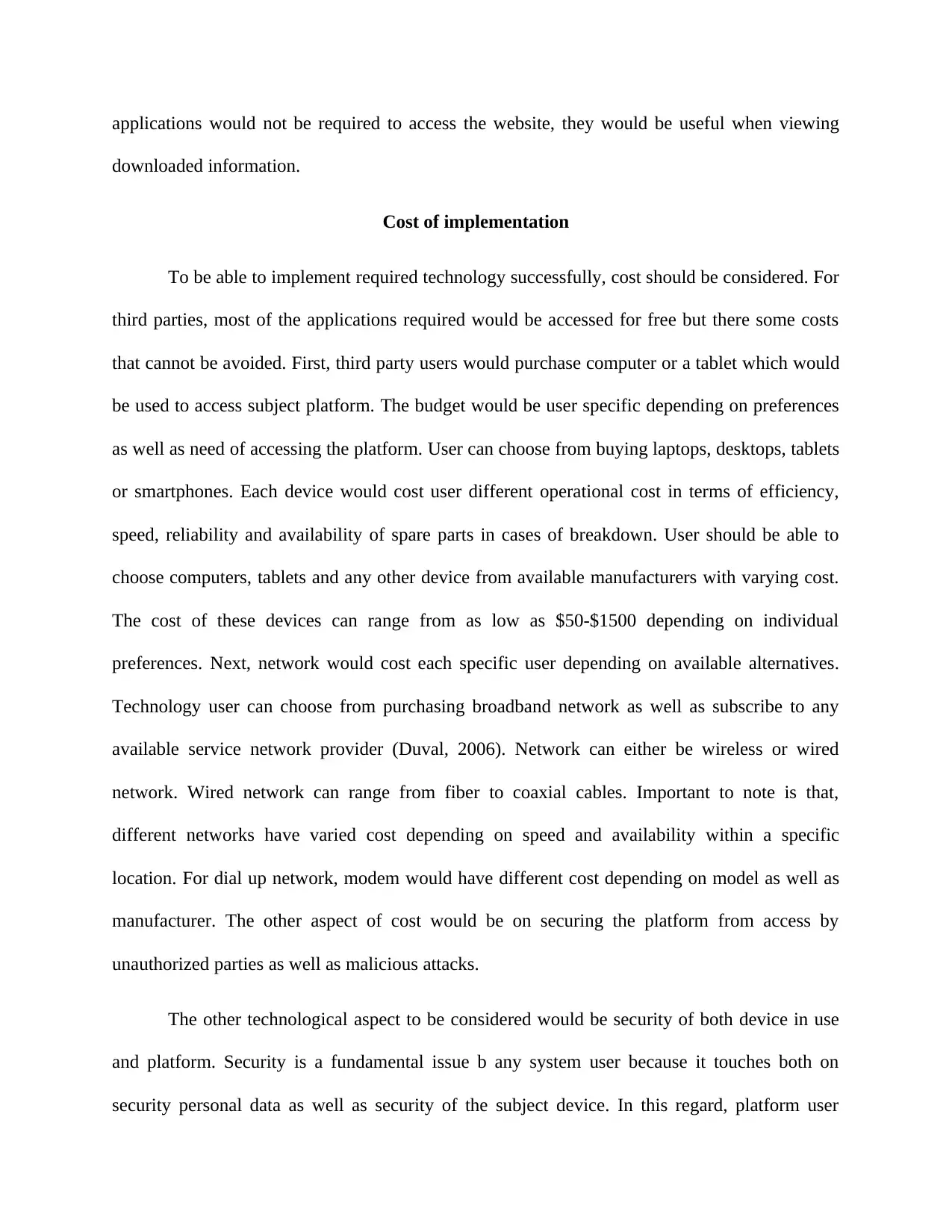
applications would not be required to access the website, they would be useful when viewing
downloaded information.
Cost of implementation
To be able to implement required technology successfully, cost should be considered. For
third parties, most of the applications required would be accessed for free but there some costs
that cannot be avoided. First, third party users would purchase computer or a tablet which would
be used to access subject platform. The budget would be user specific depending on preferences
as well as need of accessing the platform. User can choose from buying laptops, desktops, tablets
or smartphones. Each device would cost user different operational cost in terms of efficiency,
speed, reliability and availability of spare parts in cases of breakdown. User should be able to
choose computers, tablets and any other device from available manufacturers with varying cost.
The cost of these devices can range from as low as $50-$1500 depending on individual
preferences. Next, network would cost each specific user depending on available alternatives.
Technology user can choose from purchasing broadband network as well as subscribe to any
available service network provider (Duval, 2006). Network can either be wireless or wired
network. Wired network can range from fiber to coaxial cables. Important to note is that,
different networks have varied cost depending on speed and availability within a specific
location. For dial up network, modem would have different cost depending on model as well as
manufacturer. The other aspect of cost would be on securing the platform from access by
unauthorized parties as well as malicious attacks.
The other technological aspect to be considered would be security of both device in use
and platform. Security is a fundamental issue b any system user because it touches both on
security personal data as well as security of the subject device. In this regard, platform user
downloaded information.
Cost of implementation
To be able to implement required technology successfully, cost should be considered. For
third parties, most of the applications required would be accessed for free but there some costs
that cannot be avoided. First, third party users would purchase computer or a tablet which would
be used to access subject platform. The budget would be user specific depending on preferences
as well as need of accessing the platform. User can choose from buying laptops, desktops, tablets
or smartphones. Each device would cost user different operational cost in terms of efficiency,
speed, reliability and availability of spare parts in cases of breakdown. User should be able to
choose computers, tablets and any other device from available manufacturers with varying cost.
The cost of these devices can range from as low as $50-$1500 depending on individual
preferences. Next, network would cost each specific user depending on available alternatives.
Technology user can choose from purchasing broadband network as well as subscribe to any
available service network provider (Duval, 2006). Network can either be wireless or wired
network. Wired network can range from fiber to coaxial cables. Important to note is that,
different networks have varied cost depending on speed and availability within a specific
location. For dial up network, modem would have different cost depending on model as well as
manufacturer. The other aspect of cost would be on securing the platform from access by
unauthorized parties as well as malicious attacks.
The other technological aspect to be considered would be security of both device in use
and platform. Security is a fundamental issue b any system user because it touches both on
security personal data as well as security of the subject device. In this regard, platform user
Paraphrase This Document
Need a fresh take? Get an instant paraphrase of this document with our AI Paraphraser
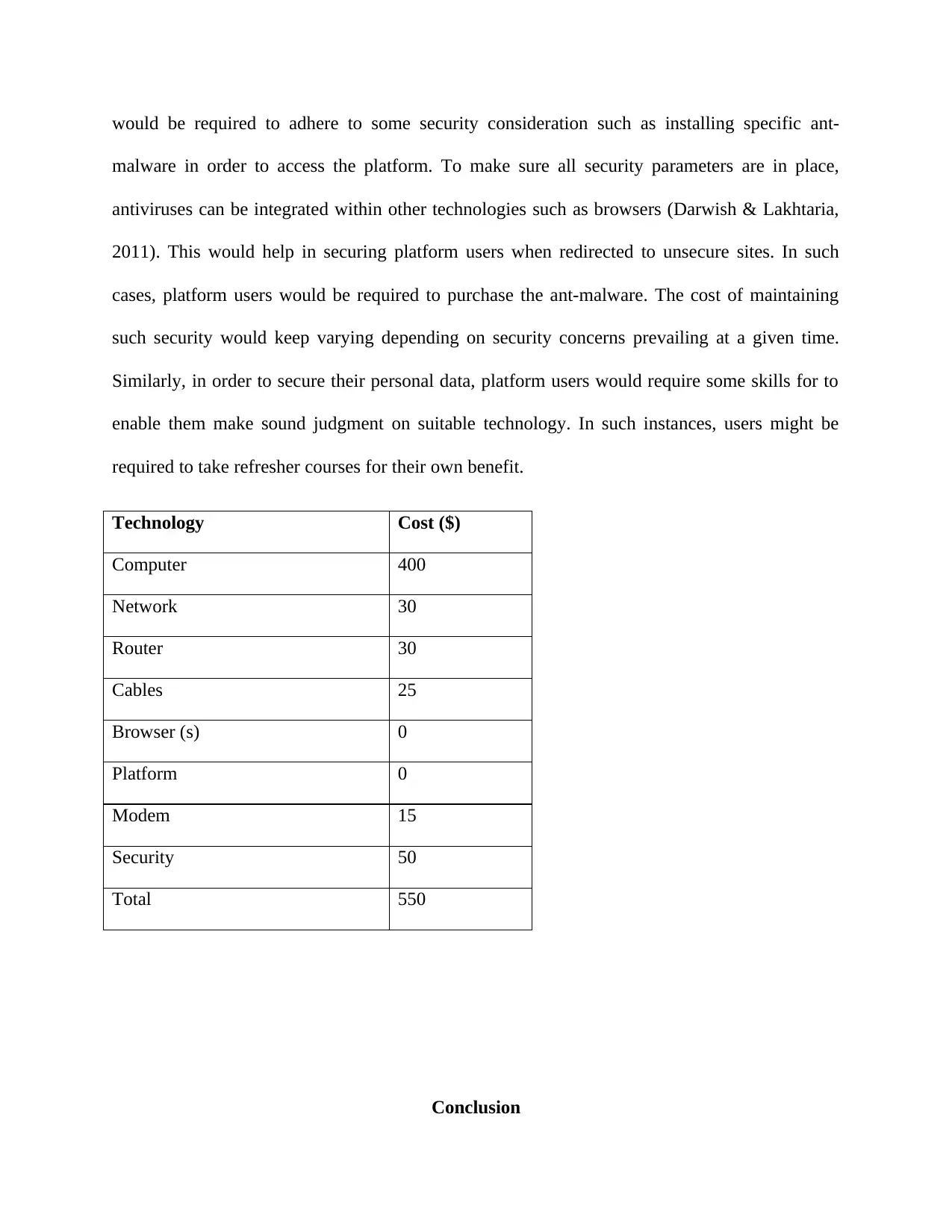
would be required to adhere to some security consideration such as installing specific ant-
malware in order to access the platform. To make sure all security parameters are in place,
antiviruses can be integrated within other technologies such as browsers (Darwish & Lakhtaria,
2011). This would help in securing platform users when redirected to unsecure sites. In such
cases, platform users would be required to purchase the ant-malware. The cost of maintaining
such security would keep varying depending on security concerns prevailing at a given time.
Similarly, in order to secure their personal data, platform users would require some skills for to
enable them make sound judgment on suitable technology. In such instances, users might be
required to take refresher courses for their own benefit.
Technology Cost ($)
Computer 400
Network 30
Router 30
Cables 25
Browser (s) 0
Platform 0
Modem 15
Security 50
Total 550
Conclusion
malware in order to access the platform. To make sure all security parameters are in place,
antiviruses can be integrated within other technologies such as browsers (Darwish & Lakhtaria,
2011). This would help in securing platform users when redirected to unsecure sites. In such
cases, platform users would be required to purchase the ant-malware. The cost of maintaining
such security would keep varying depending on security concerns prevailing at a given time.
Similarly, in order to secure their personal data, platform users would require some skills for to
enable them make sound judgment on suitable technology. In such instances, users might be
required to take refresher courses for their own benefit.
Technology Cost ($)
Computer 400
Network 30
Router 30
Cables 25
Browser (s) 0
Platform 0
Modem 15
Security 50
Total 550
Conclusion
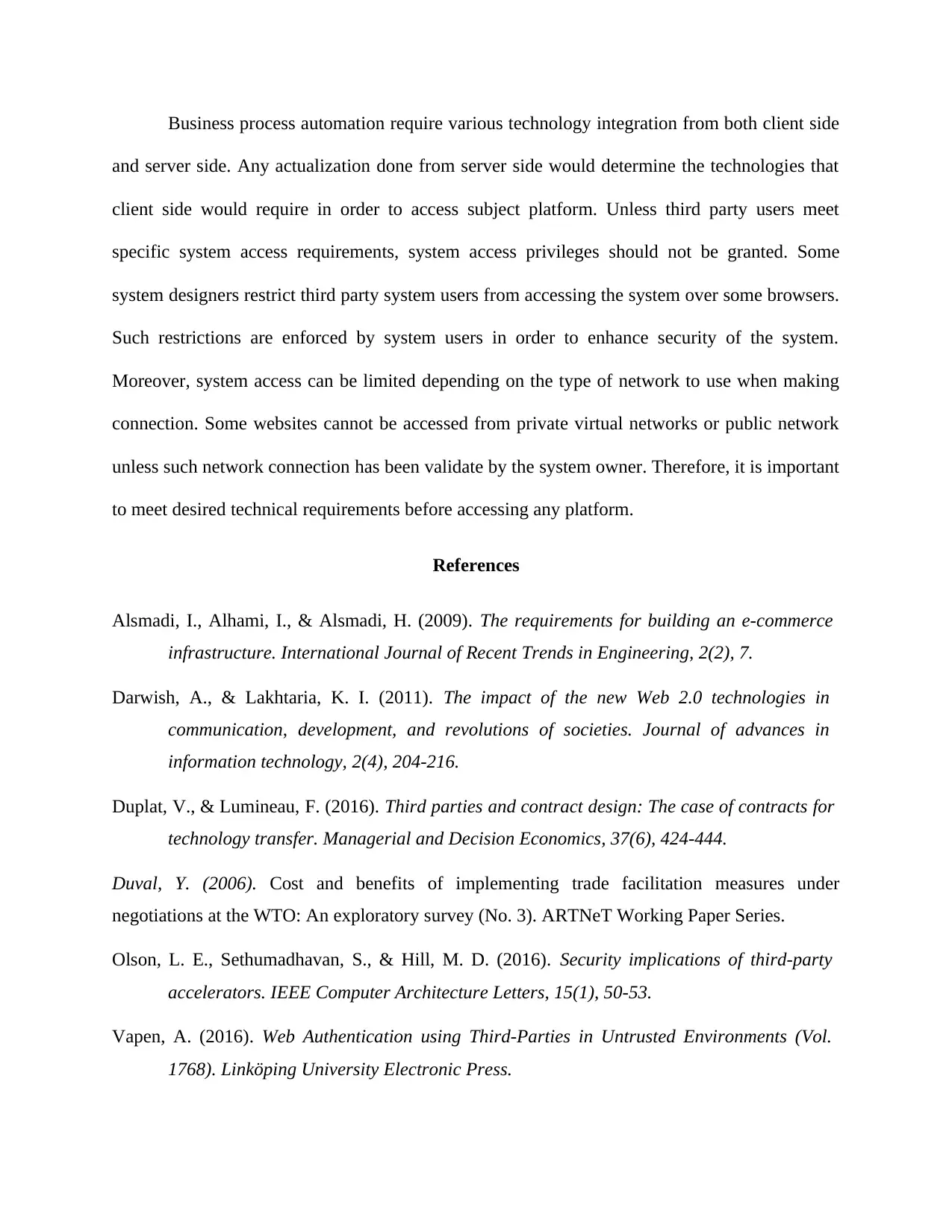
Business process automation require various technology integration from both client side
and server side. Any actualization done from server side would determine the technologies that
client side would require in order to access subject platform. Unless third party users meet
specific system access requirements, system access privileges should not be granted. Some
system designers restrict third party system users from accessing the system over some browsers.
Such restrictions are enforced by system users in order to enhance security of the system.
Moreover, system access can be limited depending on the type of network to use when making
connection. Some websites cannot be accessed from private virtual networks or public network
unless such network connection has been validate by the system owner. Therefore, it is important
to meet desired technical requirements before accessing any platform.
References
Alsmadi, I., Alhami, I., & Alsmadi, H. (2009). The requirements for building an e-commerce
infrastructure. International Journal of Recent Trends in Engineering, 2(2), 7.
Darwish, A., & Lakhtaria, K. I. (2011). The impact of the new Web 2.0 technologies in
communication, development, and revolutions of societies. Journal of advances in
information technology, 2(4), 204-216.
Duplat, V., & Lumineau, F. (2016). Third parties and contract design: The case of contracts for
technology transfer. Managerial and Decision Economics, 37(6), 424-444.
Duval, Y. (2006). Cost and benefits of implementing trade facilitation measures under
negotiations at the WTO: An exploratory survey (No. 3). ARTNeT Working Paper Series.
Olson, L. E., Sethumadhavan, S., & Hill, M. D. (2016). Security implications of third-party
accelerators. IEEE Computer Architecture Letters, 15(1), 50-53.
Vapen, A. (2016). Web Authentication using Third-Parties in Untrusted Environments (Vol.
1768). Linköping University Electronic Press.
and server side. Any actualization done from server side would determine the technologies that
client side would require in order to access subject platform. Unless third party users meet
specific system access requirements, system access privileges should not be granted. Some
system designers restrict third party system users from accessing the system over some browsers.
Such restrictions are enforced by system users in order to enhance security of the system.
Moreover, system access can be limited depending on the type of network to use when making
connection. Some websites cannot be accessed from private virtual networks or public network
unless such network connection has been validate by the system owner. Therefore, it is important
to meet desired technical requirements before accessing any platform.
References
Alsmadi, I., Alhami, I., & Alsmadi, H. (2009). The requirements for building an e-commerce
infrastructure. International Journal of Recent Trends in Engineering, 2(2), 7.
Darwish, A., & Lakhtaria, K. I. (2011). The impact of the new Web 2.0 technologies in
communication, development, and revolutions of societies. Journal of advances in
information technology, 2(4), 204-216.
Duplat, V., & Lumineau, F. (2016). Third parties and contract design: The case of contracts for
technology transfer. Managerial and Decision Economics, 37(6), 424-444.
Duval, Y. (2006). Cost and benefits of implementing trade facilitation measures under
negotiations at the WTO: An exploratory survey (No. 3). ARTNeT Working Paper Series.
Olson, L. E., Sethumadhavan, S., & Hill, M. D. (2016). Security implications of third-party
accelerators. IEEE Computer Architecture Letters, 15(1), 50-53.
Vapen, A. (2016). Web Authentication using Third-Parties in Untrusted Environments (Vol.
1768). Linköping University Electronic Press.
⊘ This is a preview!⊘
Do you want full access?
Subscribe today to unlock all pages.

Trusted by 1+ million students worldwide

1 out of 7
Related Documents
Your All-in-One AI-Powered Toolkit for Academic Success.
+13062052269
info@desklib.com
Available 24*7 on WhatsApp / Email
![[object Object]](/_next/static/media/star-bottom.7253800d.svg)
Unlock your academic potential
Copyright © 2020–2025 A2Z Services. All Rights Reserved. Developed and managed by ZUCOL.




